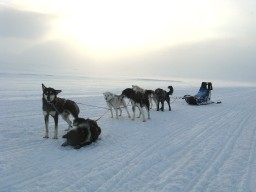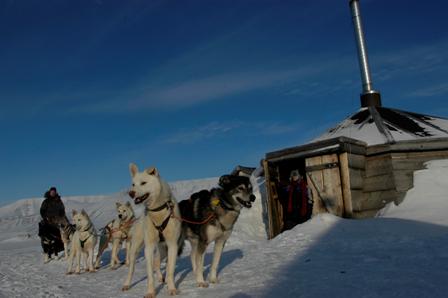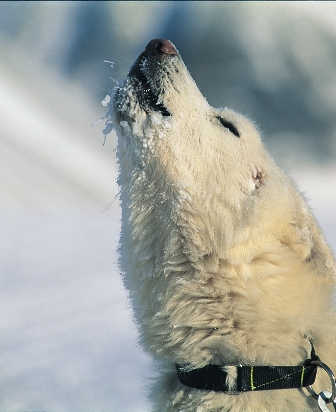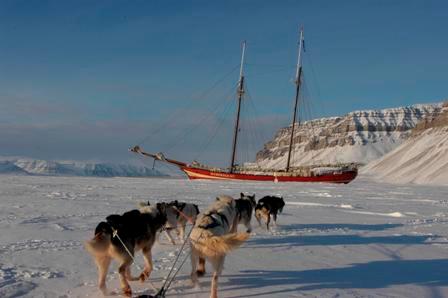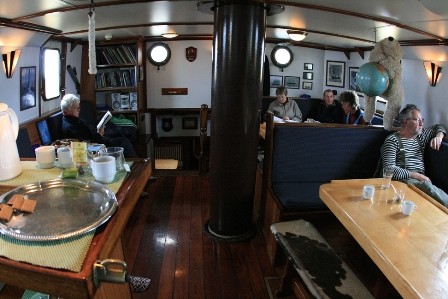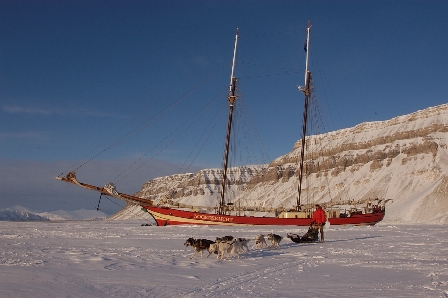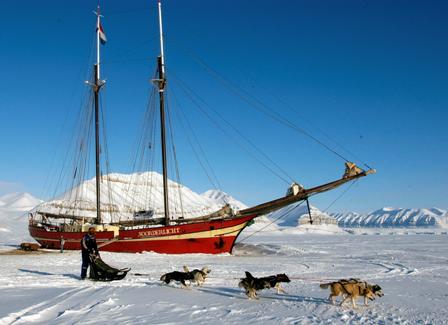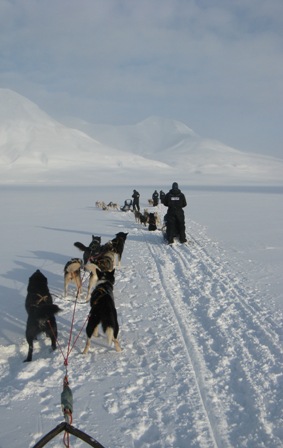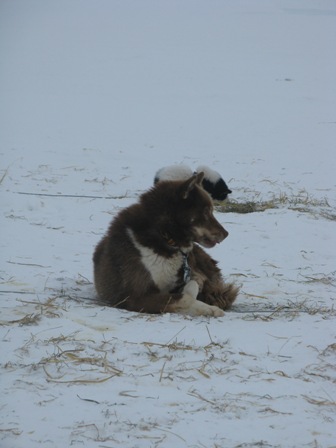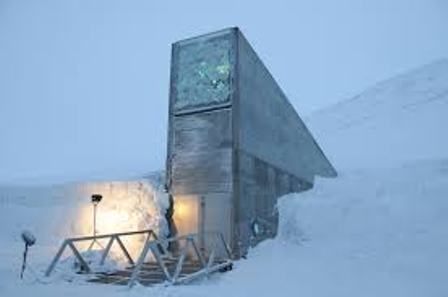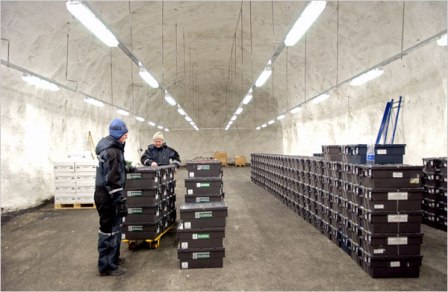Dogs are supposedly man’s best friend. In the frozen lands of Norway’s Svalbard Archipelago, dogs are also man’s best transport option.
It’s the end of the road. I’ve reached Longyearbyen on Spitsbergen Island, latitude 78.13 degrees north. This northernmost extent of permanent human habitation draws an imaginary line around the globe and Longyearbyen is the only dot on that line. The North Pole is a mere 1,338 kilometres further.
No people live permanently between Svalbard and the North Pole. Norway’s capital city, Oslo is 2,313 kilometres south while the nearest town of any consequence, Tromso, the capital of Norway’s Arctic Region, is an hour’s flight south some 1,000 kilometres across the Arctic Ocean.
I’m here to join a dogsled expedition to the ‘Ship in the Ice’, a two-masted refurbished schooner stuck fast in the thick ice of Tempelfjord, a hard day’s journey across frozen wilderness populated by reindeer, polar bears and Arctic foxes.
During late March, each day grows longer by an average of 40 minutes. When I arrived to participate in the dog sledging tour, sunset was at 7pm. A week later I write notes about huskies and polar bears at 11pm while an eerie light illuminates the sky. The evening view from my hotel window is all blue and white with shades of grey shining off nearby peaks. The Aurora Borealis flashes streaks brilliant green with reddish orange tints while disappearing in scintillating seconds.
Sunrise is at 3:30am. By 19 April the sun won’t set again until late August. Spring has arrived finally and the locals are behaving as if they’ve been released from four months of darkened prison confinement.
The town’s few bars are full. Sustained exuberance is in ample evidence.
Cognac is the preferred tipple. Good incomes can be made here in Longyearbyen from scientific research projects, coal mining and seasonal tourism. Longyearbyeners have survived another winter of frigid darkness and the festive mood coincides with increasing sunlight.
Some 2,300 hardy souls live on this huge archipelago, mostly in the capital town, Longyearbyen. Svalbard’s islands constitute an area roughly the size of Denmark.
At the Svalbard Museum I read two forbidding descriptions of life in this isolated frigid place, one written in 1935 by Christiane Ritter: ‘This place is abandoned by God and ought to have been abandoned a long time ago by mankind as well.’ I’m told a few dozens of fringe dwellers live further a field, isolated for months at a time, subsisting off fur trapping or fishing. The second description is more daunting, ‘The ability to adapt, and the art of resignation, is some of what is needed most by those who shall live in Svalbard,’ wrote Liv Balstad in 1956. My ability to adapt to Svalbard’s extreme conditions will be sorely tested.
Approximately 3,000 polar bears also live on Svalbard. During four days of dog sledging around the main island Spitsbergen, I’ve seen a few bears from a safe distance. One bear was in the vicinity of the dog camp five kilometres from town. It was spotted strolling down the same icy snow covered path I and my motley dog team were using the previous evening. Seal pups have left their dens and are following their parents to open water. Polar bears instinctively follow as the sea ice begins breaking up outside the fjords, the best time to fatten up before the lean summer months. Spring is prime time to fatten up on seal pups before summer’s thaw, the hardest season for hungry polar bears.
While ice packs recede in warmer Arctic Ocean waters, seal hunting has become even more challenging for the bears. I know hungry bears are less discriminating when an easy meal is available. As a weak and slow-footed human, I’d be considered an easy meal. One of my two dog sledging guides explains to me when I ask about polar bear attacks: ‘They prefer fatty seals to skinny humans.’ I take her remark as a wayward compliment but also note a recent bear attack on a group of young English campers during a summer school excursion. One student was killed and several were injured. The guilty bear was shot dead. The bears I see are searching for food elsewhere; I am indeed ignored.
Dog sledging (dog-sledding) is hard work. I thought I’d be gently pulled across frozen fjords and glaciated valleys, standing at the back of my sledge, the master of my domain. Like a scene from a Judy Garland movie when everyone is singing light opera in open horse-drawn carriages, a fantasy that has proven very far from reality. Instead my arms ache from righting the constantly wavering sledge. Legs are like solid trunks of ice, inflexible and stiff. My back hurts from manhandling the dogs, lifting them by their shoulder harnesses and pulling them into line when they become recalcitrant.
Frostbite is a real concern. To prevent it, I’m wearing two layers of thermal underwear, waterproof hiking trousers, a Gore-tex hooded undercoat, three pairs of socks made from three types of cold-resistant fabrics, two fleecy jumpers, a down jacket, two balaclavas, one with a nose guard to keep my nose from freezing, two scarves wrapped around my neck, a woolen cap to keep the balaclavas in place, ski goggles to protect from snow glare and wind, down under-gloves, polar mittens, polar boots with felt inner linings that reach up to my knees and a full body hooded polar suit with a waist to neck zipper. I’m unrecognisable and need fifteen minutes advanced planning to urinate; unzipping all the garments requires a degree in mechanical engineering.
The dogs must be cared for by their sledge masters: fed twice a day on specially fattened super rich husky food interspersed with treats of frozen seal meat and blubber. Their droppings must be shoveled and removed to a safe location hundreds of metres away from base camp so as not to attract hungry bears. They have to be watered (luckily my huskies like to eat snow), cuddled and reassured that all is well in this frozen wasteland of cold affection.
After breakfast when it’s time to venture forth into the great white beyond, the madly eager dogs are collected from their open air sleeping spots, (hay is used for bedding which helps insulate them from the ice) coaxed into their leads then harnessed to the sledge’s main lead rope in a rigidly prescribed pecking order so as to avoid unnecessary squabbles. The entire team is then secured from a chain attached to an ice pick driven securely into the snow, the other end to the two lead dogs. The sledge anchor must always remain pushed hard into the snow so the dogs don’t take off like bats out of hell without a driver. When all sledges and drivers with teams of six dogs each are lined up, we’re finally ready to mush off into the blisteringly cold daylight. This represents ninety minutes of physically demanding work.
We are a group of six travellers with two guides, responsible for our own sledges and dogs, though feeding and shoveling duties are shared among us. There are eight humans, seven with teams of six dogs each with one of our two armed guides driving ten dogs for his larger sledge. His dogs are Greenland huskies, larger and more rambunctious than the other teams of Alaskan huskies which are slightly smaller and of varying gentler temperaments. We travel with 46 dogs in total. Five other dogs are already in residence at our base camp, the Noorderlicht or ‘North Light’, ship in the Tempelfjord approximately 50 kilometres hard travelling northeast from Longyearbyen.
It takes us almost seven hours to reach the ship, our welcoming home in the ice. We cover the distance without serious mishap apart from mild frostbite and aching muscles. The temperature varies between -25C and -20C with winds up to 70 kilometres per hour. The wind chill of approximately -85C is scary cold. One minute of exposed flesh results in bad frostbite.
Driving the sledges over jagged windswept plains, up and down sharp ice ridges and through dry snow drifts that can easily tip over a shaky sledge isn’t a doddle in the ice park. The sledges have no brake pads, no steel springs or shock absorbers. The driver stands on two runners at the back and holds on for dear life while balancing one foot on a runner and the other over a steel frame attached to metal claws that serve as emergency brakes. If one team runs along another or overtakes it, chaos ensues as the dogs begin barking loudly at each other, or fornicating or fighting. The melee’s noise can be deafening.
The second day we drive our sledges up the frozen Tempelfjord past Kap Schultz to the base of the Tuna glacier. It’s so cold I fall into a mild coma of incomprehension. I’ve been looking through a tunnel of fleece, down and synthetic garments with such intense focus I can’t really see anything apart from my feet and the dogs in front of me. Removing one of two balaclavas, parka hood and polar suit hood, I look up and see a blue white cliff towering over me. I take my camera from its bag resting inside the sledge pack but the shutter is frozen. The new batteries are dead, an effect of sub-zero temperatures. The glacier’s other-worldliness justifies the journey in itself without photos; it’s a breath-taking sight.
Dog sledging can be noisy. The dogs always begin barking as soon as the sledge stops moving. They don’t bark when they’re exhausted, almost never, or when asleep. They are quite remarkable animals however, resilient, tough, intelligent, often comical, each one possessed of a singular personality. When trotting at a steady pace over smooth ice or wind-swept clean flat snow, they’re strangely quiet. Only panting and gentle foot pads softly touching the icy surface can be heard, a magical series of brief moments.
We leave the glacier to ascend a nearby mountain whose summit shelters the hidden Nuisda valley. One of the guides visited two years previously and believes it will be a sheltered place in which to stop for lunch. Before ascending the steep slope that leads to the valley, he fires a gunshot into the air checking for avalanche possibility—though I think the dogs could have barked down an entire mountain of snow without a problem. I push my sledge uphill with the dogs pulling hard. They look backwards constantly checking to ensure I’m doing my fair share of pushing the heavy sledge. If I stop pushing uphill through deep snow, the dogs stop pulling and we began to slide downhill. The dogs view this as a jolly good lark, a golden opportunity to entangle their leads like strands of well cooked spaghetti. The sorting out of leads can take hours, requiring removal of mittens, a painful experience for naked human hands so I push while keeping my team together.
After much pushing and cajoling the dogs, shoving the proverbial up a steep hill, we reach a prime picnic position in the sheltered leeward side of the valley. Our field lunch is a freeze dried packet of organic meat stew. Served in a cup, I pour hot water over both it and me because of my cold clumsy mitten clad hands. I drink warm reconstituted currant juice and nibble at a bit of frozen chocolate. Seated cross-legged on reindeer skins in a semi-circle of snow, we look very much, I imagine, like a line of frozen seated Buddha statues. My dogs grab the opportunity to nap, curling themselves into tight circles, heads tucked under brushy tails, backs facing the wind. Within seconds they’ve calmed into tranquil silence. The wind subsides and quiet pervades. No one speaks when raw beauty of this grandeur speaks for itself.
After lunch, we cross to the other side of the valley searching for a way back to Tempelfjord; it’s unmarked territory. We haven’t seen anyone for two days apart from a few travellers on fast snowmobiles, their revving engines reminding me that dog’s barking is infinitely preferable to a snowmobile engine’s shrill pitch.
The navigational challenge of descending the valley necessitates an interesting dog sledge manoeuvre I call ‘ski sledging’. One foot remains on the brake so the sledge doesn’t overtake the dogs. The other foot balances the sledge itself. I make it safely all the way down the steep slopes but run into a snow drift metres from the bottom. The sledge and I almost part company. During the expedition briefing a day before leaving Longyearbyen, I was told in no uncertain terms that I must NEVER EVER NEVER EVER let go of my sledge if I fall off. The dogs will continue to run all the way to Russia via Canada and I will have to find them… on foot. Holding on with my right hand, I’m dragged for twenty metres across hard sharp ice, bruising my shoulder. The loosened anchor fortunately catches hold of the ice and the sledge slows enough allowing me to grab hold with my free left hand. Back in standing position I push hard on the brake. When the sledge finally stops each of my six furry friends looks back at me as if to ask, ‘What the hell are you doing with our ride?’
Never one to let an interesting experience happen just once, feeling cheekily confident after four days of dog sledging, on our last day I fall off the sledge again while making a sharp turn uphill outside the main dog camp. Three other fellow dog mushers make the same misjudgement in taking the sharp turn too quickly and cop it much worse than me. Eighteen dogs are now tangled up in blue so to speak and it takes two hours of collective effort to sort out the mess before finally heading back to Longyearbyen, a warm shower and a quiet meal without the background music of barking dogs.
I suspect that my dog sledging days are numbered. The intensely felt moments of perfection when the dogs are jogging together in silent union, when all around is serenely wonderful and the earth is a majestic white jewel are in distinct disproportion to the innumerable hours of struggle against nearly impossible elements: weather, track conditions, frostbite and fatigue. This combined with canine cunning winning nine times out of ten against human ineptitude has surely put me off becoming anything but an amateur dog sledger.
On second thought, practice does make perfect.
Tom Neal Tacker travelled courtesy of 50 Degrees North, Thai Airways and SAS Airways.
Naked Facts:
50 Degrees North offers dog sledging and other trips to Svalbard during the short spring season, March and April. See www.fiftydegreesnorth.com or contact 1300 422 821 for more information. Costs for a Dogsled Expedition to the Ship in the Ice are approximately $AUD3,510 per person including most meals, safety equipment, polar suits and boots, accommodation for three nights onboard the ‘Noorderlicht’ and two nights at Basecamp Trapper’s Lodge in central Longyearbyen. Extra nights at Trapper’s Lodge are from 1450 Norwegian Kroner (AUD$250) a night. The meals cooked on board the ‘Nooderlicht’s’ tiny galley are surprisingly tasty and nutritious. Full credit to the crew (two very resourceful Dutch women) for their ingenuity, resourcefulness and warm hospitality.
SAS has a return fare from Oslo to Longyearbyen via Tromso from approximately $AUD500 depending on the season. See www.flysas.com
Naked Eats:
The Huset restaurant, café and nightclub two kilometres from Trapper’s Lodge, offers superb dining. Local delicacies such as Arctic char, reindeer and cloudberries accompany a surprisingly extensive wine list. See www.huset.com and be sure to reserve first, Tel: +79 02 25 00. Open Monday to Sunday from 19:00 until 22:00 for dinner.
The Kroa restaurant and bar behind Trapper’s Lodge in Longyearbyen’s Sentrum district is funky and fun serving well prepared food. Try their specially imported Jenssen XO Cognac ‘on tap’. The seafood soup or one of the smoked fish pizzas is recommended. Reserve a table first. Tel: +79 02 13 00. Open 7 days and nights.
Naked Tips:
Inevitably, a few days will be passed in Longyearbyen. Don’t miss the town’s historical museum located on the fjord edge off the main road to and from the airport. See www.svalbardmseum.no for more information.
Near the airport on the north facing side of a mountain juts a glassy glittering gateway to a secret world, a single lane road running off the main drag between town and the airport winds up to what appears to be a rather expensively kitted out mine shaft. Here lies the Global Seed Vault, established early this century by an international consortium of science organisations. The striking entry was designed by a local architectural firm, the tunnels cleverly drilled into rocky permafrost by a local engineering company, Leonhard Nilsen & Sonner. Something of an engineering marvel, the tunnels require constant maintenance as the permafrost continually buckles walls, floors and door frames.
Sadly, the Global Seed Vault is off limits to casual visitors. Luckily I was allowed inside for a couple hours to see the planet’s essential safeguard for our continuing existence if nuclear holocaust or a natural catastrophe occurs and most of the world’s population is obliterated, crops are destroyed and harvests dwindle to nothing.
If human beings are to survive, food must be found. Hopefully to ensure our future if worse comes to worst, millions of seeds collected from around the planet are stored in deep tunnels drilled into permafrost, the seeds’ vitality is more or less guaranteed for thousands of years.
The project is an ongoing one. Currently over 3 million seeds are in storage. More are being added regularly. Lined up on shelves, protected in thick plastic sealed bags then stacked in specially designed boxes, these seeds represent mankind’s best effort to face a plausible reality, frightening as it may seem. The implicit future the Global Seed Vault represents sends chilling thoughts deep into my soul as I wander through deep tunnels filled with seeds to save us from our most horrific nightmare.
See www.regjeringen.no for more information.

